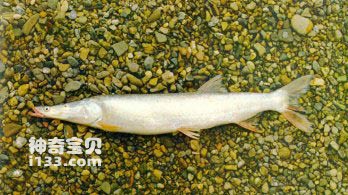Luciobrama macrocephalus (Luciobrama macrocephalus) belongs to the order Cyprinidae, family Cyprinidae, subfamily Auropodinae, and genus Luciobrama. Common names: Fire pipe, pointed-headed catfish, horse-headed catfish, duck-billed catfish, duck-billed catfish, crane-billed catfish, long-billed catfish, trumpet fish, and large tube-billed catfish. English name: Long spikyhead carp.
Endangerment level: Vulnerable.
The body is slender and slightly cylindrical. The abdomen is round without edges, the head is slender, the front part is slightly tubular, and the snout is flat and duckbill-shaped. The mouth is small and located upward, with the lower jaw sloping upward and longer than the upper jaw. The cheek is flattened laterally. The eyes are small, located on the upper side of the head, close to the tip of the snout; the length of the head behind the eyes is about 2.5 times the length of the snout. The hypopharyngeal teeth are slender and slightly curved at the end. The scales are small, and the dorsal fin starts above the pelvic fin; the caudal fin is deeply bifurcated, and the lower lobe is slightly longer than the upper lobe. The body is bluish gray, the abdomen is silvery white; the pectoral fins are light red, the dorsal fins, pelvic fins and anal fins are grayish white, and the trailing edge of the caudal fin is slightly black.

It lives in the middle and lower layers of rivers or lakes. It is vigorous and fierce, and has strong swimming ability. It can swallow other fry when they are young. When the body length is less than 30 centimeters, they will swim in the middle and upper layers of the water to grab other fish for food; the adults will use their long snout to find small fish in the stone crevices. They are extremely gluttonous in nature. Even though the digestive tract is full of food, they continue to swallow it, and eventually the semi-digested food is squeezed out from the anus. The growth rate is fast, the age of sexual maturity is over 5 years old, and the reproductive period is from April to July. Mature broodstock fish go upstream to the sections of rivers where the water flow is faster in spring to breed. The juvenile fish are fattened in lakes and feed on cladocerans and fish fry in the juvenile stage; the adult fish turns to fish-eating, often using its long tube-shaped snout to forage for small fish in rock crevices or aquatic plants.
The catfish is a species endemic to my country and is only found in the Yangtze River and other water systems south of the plains in southeastern my country.
The catfish grows very fast, with a growth rate of 1-2 kilograms per age, especially the 5-year-old fish grows more rapidly. The largest individual can weigh more than 50 kilograms. It is a large and ferocious economic fish, and its natural output is not as high as that of the anchovy. Because it eats a large number of other fry from the fry stage, it does great harm to the four major fish species including herring, grass carp, silver carp, and bighead carp, so it is listed as a target that must be eliminated by the aquaculture industry. The fish has tender meat, few spines, and is relatively large, making it a top-quality edible fish. Its meat is used freshly as medicine. It is beneficial to the muscles, bones, spleen and stomach. It is mainly used to treat soreness and weakness in the waist and knees, weak spleen and stomach, and loss of appetite. It should be taken regularly.
In recent years, due to overfishing, the obstruction of rivers and lakes, which affects the ability of young fish to enter lakes for life and fattening, and the overall decline of fish resources in large rivers, resulting in food shortages for large and ferocious carnivorous fish, the number of individuals in the tiger population has been significantly reduced. It is now difficult to see individuals.
animal tags:
We created this article in conjunction with AI technology, then made sure it was fact-checked and edited by a Animals Top editor.